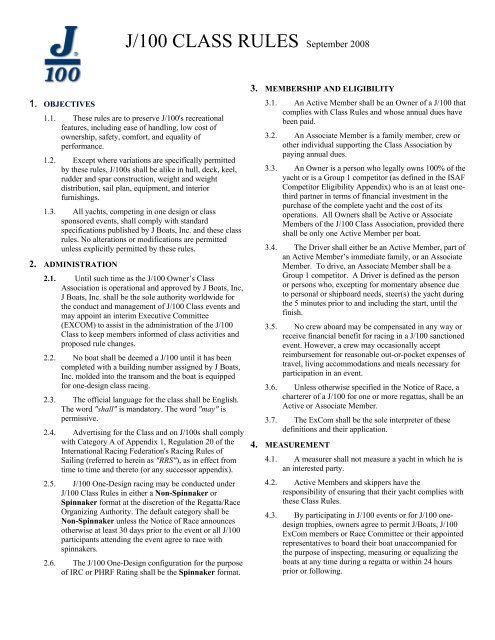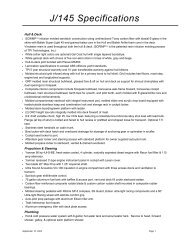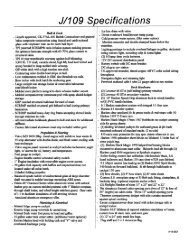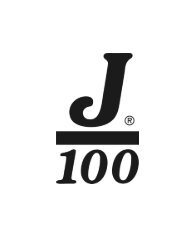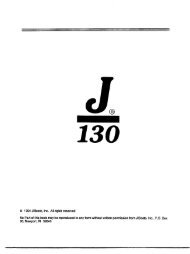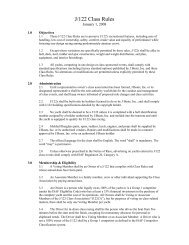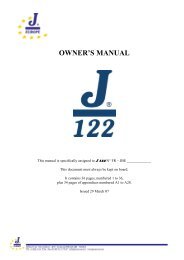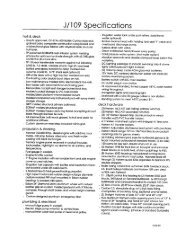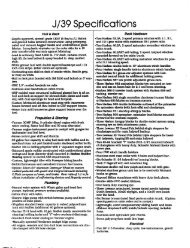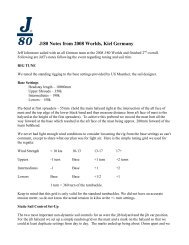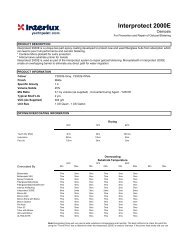You also want an ePaper? Increase the reach of your titles
YUMPU automatically turns print PDFs into web optimized ePapers that Google loves.
J/100 CLASS RULES September 2008<br />
1. OBJECTIVES<br />
1.1. These rules are to preserve J/100's recreational<br />
features, including ease of handling, low cost of<br />
ownership, safety, comfort, and equality of<br />
performance.<br />
1.2. Except where variations are specifically permitted<br />
by these rules, J/100s shall be alike in hull, deck, keel,<br />
rudder and spar construction, weight and weight<br />
distribution, sail plan, equipment, and interior<br />
furnishings.<br />
1.3. All yachts, competing in one design or class<br />
sponsored events, shall comply with standard<br />
specifications published by J Boats, Inc. and these class<br />
rules. No alterations or modifications are permitted<br />
unless explicitly permitted by these rules.<br />
2. ADMINISTRATION<br />
2.1. Until such time as the J/100 Owner’s <strong>Class</strong><br />
Association is operational and approved by J Boats, Inc,<br />
J Boats, Inc. shall be the sole authority worldwide for<br />
the conduct and management of J/100 <strong>Class</strong> events and<br />
may appoint an interim Executive Committee<br />
(EXCOM) to assist in the administration of the J/100<br />
<strong>Class</strong> to keep members informed of class activities and<br />
proposed rule changes.<br />
2.2. No boat shall be deemed a J/100 until it has been<br />
completed with a building number assigned by J Boats,<br />
Inc. molded into the transom and the boat is equipped<br />
for one-design class racing.<br />
2.3. The official language for the class shall be English.<br />
The word "shall" is mandatory. The word "may" is<br />
permissive.<br />
2.4. Advertising for the <strong>Class</strong> and on J/100s shall comply<br />
with Category A of Appendix 1, Regulation 20 of the<br />
International Racing Federation's Racing <strong>Rules</strong> of<br />
Sailing (referred to herein as "RRS"), as in effect from<br />
time to time and thereto (or any successor appendix).<br />
2.5. J/100 One-Design racing may be conducted under<br />
J/100 <strong>Class</strong> <strong>Rules</strong> in either a Non-Spinnaker or<br />
Spinnaker format at the discretion of the Regatta/Race<br />
Organizing Authority. The default category shall be<br />
Non-Spinnaker unless the Notice of Race announces<br />
otherwise at least 30 days prior to the event or all J/100<br />
participants attending the event agree to race with<br />
spinnakers.<br />
2.6. The J/100 One-Design configuration for the purpose<br />
of IRC or PHRF Rating shall be the Spinnaker format.<br />
3. MEMBERSHIP AND ELIGIBILITY<br />
3.1. An Active Member shall be an Owner of a J/100 that<br />
complies with <strong>Class</strong> <strong>Rules</strong> and whose annual dues have<br />
been paid.<br />
3.2. An Associate Member is a family member, crew or<br />
other individual supporting the <strong>Class</strong> Association by<br />
paying annual dues.<br />
3.3. An Owner is a person who legally owns 100% of the<br />
yacht or is a Group 1 competitor (as defined in the ISAF<br />
Competitor Eligibility Appendix) who is an at least onethird<br />
partner in terms of financial investment in the<br />
purchase of the complete yacht and the cost of its<br />
operations. All <strong>Owners</strong> shall be Active or Associate<br />
Members of the J/100 <strong>Class</strong> Association, provided there<br />
shall be only one Active Member per boat.<br />
3.4. The Driver shall either be an Active Member, part of<br />
an Active Member’s immediate family, or an Associate<br />
Member. To drive, an Associate Member shall be a<br />
Group 1 competitor. A Driver is defined as the person<br />
or persons who, excepting for momentary absence due<br />
to personal or shipboard needs, steer(s) the yacht during<br />
the 5 minutes prior to and including the start, until the<br />
finish.<br />
3.5. No crew aboard may be compensated in any way or<br />
receive financial benefit for racing in a J/100 sanctioned<br />
event. However, a crew may occasionally accept<br />
reimbursement for reasonable out-or-pocket expenses of<br />
travel, living accommodations and meals necessary for<br />
participation in an event.<br />
3.6. Unless otherwise specified in the Notice of Race, a<br />
charterer of a J/100 for one or more regattas, shall be an<br />
Active or Associate Member.<br />
3.7. The ExCom shall be the sole interpreter of these<br />
definitions and their application.<br />
4. MEASUREMENT<br />
4.1. A measurer shall not measure a yacht in which he is<br />
an interested party.<br />
4.2. Active Members and skippers have the<br />
responsibility of ensuring that their yacht complies with<br />
these <strong>Class</strong> <strong>Rules</strong>.<br />
4.3. By participating in J/100 events or for J/100 onedesign<br />
trophies, owners agree to permit J/Boats, J/100<br />
ExCom members or Race Committee or their appointed<br />
representatives to board their boat unaccompanied for<br />
the purpose of inspecting, measuring or equalizing the<br />
boats at any time during a regatta or within 24 hours<br />
prior or following.
J/100 CLASS RULES September 2008<br />
5. EQUIPMENT RULES<br />
5.1. Standard factory supplied furnishings and<br />
equipment, including but not limited to the swim ladder,<br />
jib roller furling, 12 volt battery, cooler, holding tank,<br />
head, floor boards, main settee bunk cushions, and<br />
bulkhead door shall not be relocated or removed when<br />
racing.<br />
5.2. Safety equipment shall, at least, conform to US<br />
Coast Guard regulations.<br />
5.3. PERMITTED EQUIPMENT while racing:<br />
5.3.1. Tactical instrumentation.<br />
5.3.2. GPS/VHF/Radar.<br />
5.3.3. Interior cruising and day-sailing amenities which<br />
don't enhance performance.<br />
5.3.4. Lifelines and/or pulpits with or without foredeck<br />
lifeline netting, shroud/lifeline rollers & other antichafing<br />
gear.<br />
5.3.5. Installed genoa tracks not used.<br />
5.3.6. U-bolts or pad eyes outboard of standard jib track<br />
for barber-hauling the jib, or affixing blocks to the<br />
stanchion bases or chain plates for the same<br />
purpose.<br />
5.3.7. Block and tackle Cunningham.<br />
5.3.8. Moving mainsheet swivel base forward of traveler.<br />
5.3.9. Additional foot braces, hand holds, or harness<br />
attachment points.<br />
5.3.10. Spinnaker turning blocks, twings, tack line, one<br />
pair of spinnaker sheets (e.g. no specialty light air<br />
sheets) and halyard.<br />
5.3.11. Non-factory tiller with standard tiller head, tiller<br />
straps and fasteners weighing not less than 5 kgs<br />
(11 lbs.)<br />
5.3.12. One toggle in the backstay and/or forestay.<br />
5.3.13. “J” length, double-bridled whisker pole not<br />
longer than 3505 mm, measured from the<br />
centerline of plunger pins, with related<br />
blocks/tackle and cleats.<br />
5.3.14. Optional Self-Tacking Jib Boom.<br />
5.3.15. Storage bags of any size, number and location<br />
for the purpose of storing lines and other portable<br />
equipment.<br />
5.3.16. Substitution of blocks, cleats, tiller extension<br />
and turnbuckles by non-standard manufacturers,<br />
provided that the replacement part is of similar<br />
size, weight, power ratio and performs the same<br />
function.<br />
5.4. EQUIPMENT NOT PERMITTED while racing:<br />
6. SAILS<br />
5.4.1. Halyard locks or hooks.<br />
5.4.2. Non-standard holes or tubes which feed halyards<br />
or control lines through the deck, hull or transom.<br />
5.4.3. A Rudder or Keel with a profile outside the<br />
tolerances permitted by Official J/100 <strong>Class</strong><br />
Offsets.<br />
5.4.4. Use of a mast or boom which has been modified in<br />
any way, such as cutting off the mast butt to<br />
increase rake.<br />
6.1. A sail shall comply with the class rules in effect on<br />
the date of delivery of the sail or at event<br />
measurement.<br />
6.2. All sail measurements shall be carried out in<br />
accordance with the Equipment <strong>Rules</strong> of Sailing<br />
("ERS") and be manufactured from materials approved<br />
for use in IMS and commencing with sails delivered<br />
after January 1, 2005, shall have affixed at the tack by<br />
the Sailmaker, J/100 <strong>Class</strong> Royalty PAID Tags. Terms<br />
used in these class rules in bold letters are used as<br />
defined in the ERS.<br />
6.3. Sails carried aboard for one-design class racing<br />
shall be limited to one mainsail, one roller furling jib<br />
and, when prescribed by the notice of race, two<br />
spinnakers. The mainsail shall remain attached to the<br />
spars and jib attached to the headstay for the duration of<br />
a regatta.<br />
6.4. MAINSAIL.<br />
6.4.1. The dimensions of the mainsail shall not exceed:<br />
luff length (P) – 11.582m; foot length (E) –<br />
4.115m; leech length (MLE) — 12.110m; half<br />
width (MHW) — 2.675m; three-quarter width<br />
(MTW) — 1.564m and upper seven-eights width<br />
(MUW) ---- 900mm.<br />
6.4.2. The mainsail shall have a minimum un-bagged<br />
weight of 27 lbs. (12.3 kgs), excluding battens but<br />
including luff slides.<br />
6.4.3. 4 battens of any length shall be fitted so that the<br />
center of the batten pockets shall divide the leech<br />
of the mainsail into equal parts with a tolerance +/-<br />
80 mm.<br />
6.4.4. The tack ring of the mainsail shall be affixed in<br />
the standard tack fitting and the clew of the<br />
mainsail shall not be allowed to float free from the<br />
boom. The foot may otherwise be loose. At least<br />
one serviceable row of reef points shall be<br />
installed approximately parallel to the foot, with<br />
the tack point and the center of the reef point in
J/100 CLASS RULES September 2008<br />
the luff to be no closer than 1200mm. An<br />
additional set of reef points is permitted. The<br />
mainsail shall be attached to the mast with sail<br />
slides. Windows are permitted.<br />
6.4.5. The official J/100 class insignia<br />
(www.jboats.com/j100/) in blue with overall<br />
dimensions approximately 450x900mm shall be<br />
affixed on both sides of the sail between the upper<br />
two batten pockets, with the bar underneath the<br />
"J" located on, and nearly perpendicular to, a line<br />
through the mid foot point and a point on the top<br />
of the sail equidistant from head point and aft<br />
head point. National letters and sail numbers<br />
shall conform to the RRS and shall be placed<br />
between the middle two batten pockets.<br />
6.5. JIB.<br />
6.5.1. The jib LP (luff perpendicular) shall be not<br />
longer than 3.505m (approx. 100%) and the jib luff<br />
LL (luff length) shall be not longer than 11.506 m<br />
6.5.2. The jib shall have a minimum un-bagged weight of<br />
17 lbs. (7.7 kgs), including any battens.<br />
6.5.3. Not more than 3 battens of any length are<br />
permitted on the leech, provided that they do not<br />
restrict rolling the jib on the furler. Windows are<br />
permitted.<br />
6.5.4. The jib shall have a hollow leech and while racing,<br />
shall be attached to and operated on the standard<br />
roller furling system using #6 luff tape. UV<br />
protective tape may be applied to the leech and<br />
foot to cover the sail when roller furled.<br />
6.6. ASYMMETRIC SPINNAKERS<br />
6.6.1. Asymmetric spinnakers shall be manufactured<br />
from woven nylon with minimum nominal weight<br />
of not less than 40 grams per square meter with an<br />
area not greater than 80 square meters nor less than<br />
60 square meters based on the IRC area formula:<br />
SPA=((SLU+SLE)/2)*((SF+(4*SHW))/5)*.83<br />
where SLU (luff length) shall be not greater than<br />
14.0 m and SLE (leech length) shall be not greater<br />
than 12.7 m, and SMG (mid-girth) not less than<br />
.75*SF (foot).<br />
6.6.2. Adjustable leech, luff and foot lines shall be fitted.<br />
7. ADDITIONAL RULES<br />
of 100 kg (220 lbs.) for that regatta, in which case he<br />
or she shall not be subject to weigh-in or other weight<br />
check. If the sailing instructions require a weigh-in<br />
prior to the start of a regatta, a boat complying with<br />
the weight restrictions at weigh-in shall not otherwise<br />
be subject to a weigh-in during or after the regatta,<br />
except for weighing substitute crew.<br />
7.1.2 IRC or Handicap Racing Event. When racing<br />
under PHRF, IRC or other handicap system in a<br />
mixed fleet, the crew weight limits imposed by the<br />
handicap rating rule shall apply.<br />
7.2 BOAT WEIGHT.<br />
7.2.1 The total dry weight of the boat, for onedesign<br />
racing including all standard fixed fittings,<br />
factory installed optional equipment, items specified<br />
in #5.1, spars, standing rigging, standard running<br />
rigging and blocks, and installed electronics; but<br />
excluding sails, fenders, docklines, spare blocks &<br />
line, anchor & rode, tools, personal gear, safety gear,<br />
galley equipment, rafts, whisker pole, fuel & water,<br />
food & beverages or any other loose gear; shall be not<br />
less than 3000 kgs. (6600 lbs.)<br />
7.2.2 Additional weight equalization procedures may<br />
be prescribed by the J/100 <strong>Class</strong> or Notice of Race.<br />
7.3 MAST RAKE<br />
To control mast rake, the headstay system length<br />
including the standard Harken roller furling unit,<br />
measured between the centerline of the headstay pin<br />
on the mast to the centerline of the tack pin above the<br />
deck, shall be not greater than 12.15 m nor less than<br />
12.1 m.<br />
7.4 ROLL TACKING/JIBING<br />
Notwithstanding the provisions of RRS 42, 42.3 or<br />
49, hanging on the mast or shrouds to promote roll<br />
tacking or roll gybing is prohibited at all times. For<br />
purposes of RRS 49.2, roll tacking or roll gybing shall<br />
not be a "necessary task."<br />
7.5 HIKING RULE<br />
When sailing one-design* as a separate fleet, no part<br />
of the crew’s upper torso shall be outboard of the<br />
vertical line projected upward from the sheerline,<br />
perpendicular to the waterplane.<br />
* When sailing under IRC, PHRF or other handicap<br />
rules, handicap rule restrictions shall apply.<br />
7.1 CREW WEIGHT:<br />
7.1.1 One-Design Event. When racing as a onedesign<br />
fleet, the maximum crew weight (in swimming<br />
apparel) for one-design racing is 400 kilograms (882<br />
lbs.) with no limit on numbers of crew. An Owner<br />
who is the sole Driver for a regatta may elect a weight


